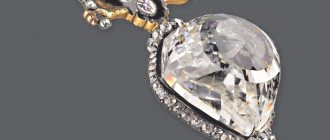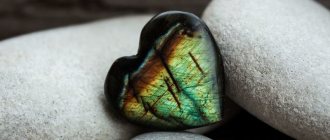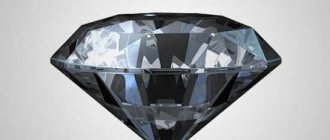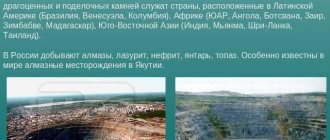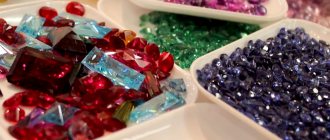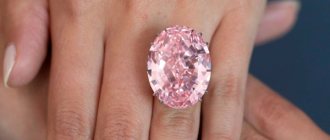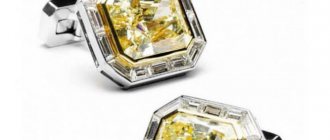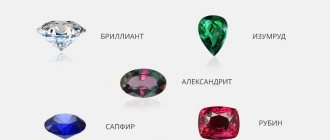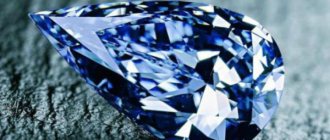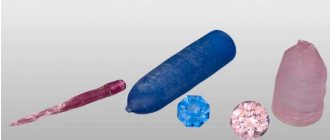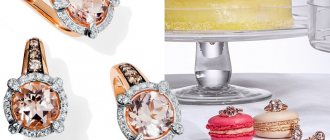Inspecting precious stones, calculating their weight and classifying stones by color and clarity is the assessment of their value. In most jewelry appraisals, the stones make up the majority of the value.
When evaluating jewelry stones, the main characteristics that are taken into account are color, clarity, cut and size. In some cases, the formation of the price of precious stones is influenced by the geography of the deposit.
When evaluating jewelry with colored stones, you must answer the following questions:
- what kind of stone is this (its name),
- whether it is natural stone or synthetic,
- Is the stone a good cut?
- are there many inclusions in it that negatively affect its beauty,
- Is the color of the stone beautiful?
- Is the color of the stone natural?
- whether the stone has been refined.
Estimation of stone mass
Weight and size affect the pricing of a gemstone. Typically, the larger the stone, the higher the price per carat. But if the stone is very large (more than 50 carats), then the price may be reduced, because it is more difficult to sell such a stone due to its very high cost, unless it is a rare gem. It is necessary to take into account the fact that stones of the same mass have different sizes, since their specific gravity is different. Some gemstones are often large in size (sapphire), others are extremely rare to weigh more than 5 carats, so they are valued more expensive (ruby).
Price per carat (200 mg) is the most common unit of comparison for colored stones. The weight of jewelry stones is indicated in carats accurate to the second decimal place. You can round up as long as the third decimal place is 9. For loose colored stones, the weight of the insert is determined by weighing on an electronic carat scale.
Electronic scales for weighing loose stones
To determine the mass of stones fixed in jewelry, it is recommended to use measuring instruments (Laveridge type, IChT-10) and various calibers.
Loveridge
Karatomer
II. Purity
“I’m just a handsome, neatly hewn Mongolian boy.” Yul Brynner
The purity of colored gemstones is only the second most important factor when evaluating them. Natural colored stones are almost never as pure as diamonds, and they cannot be graded using the same criteria as diamonds. Popular and expensive gemstones such as emeralds, rubies and alexandrites are extremely rare to be pure. Cleanliness and transparency are of course always desirable, but color is still of paramount importance. Precious stones have different chemical compositions, different crystal structures, and grew and matured in different geological conditions. Some of them are never clean and completely transparent. And if from Amethysts, Topazes, Citrines, Kunzites, Tanzanites, yellow Beryls and Chrysoberyls one can still expect the absence of inclusions visible to the naked eye, then it is difficult or even very difficult to count on this for Alexandrites, Sapphires, Rubies, Andalusites, Iolites, Garnets, Spinels, Tourmalinov ... Well, if you're lucky, get ready to pay a serious price...
In some cases, very strong inclusions in stones are not a disadvantage, but rather an advantage, and significantly increase the value of the stone. The best star sapphires and rubies, chrysoberyls and cat's eye scapolites are usually almost opaque. These stones are very strongly included, but microscopic in size inclusions reflect light in a special way and produce these effects - a “multi-beam star” or “cat’s eye”.
Determining the shape and type of cut
Faceted is a stone with flat polished surfaces - edges. The concept of "cut" includes the proportions and finishing of a gemstone. It also refers to the shape or design resulting from the processing process.
Various types and shapes of jewelry stones
The shape and type of cut of a gemstone should ensure its external beauty, a high degree of play and brilliance. For some stones there is a basic (traditional) shape: for emerald - emerald shape ("octagon"), for sapphires - oval, etc.
The type of cut is determined by the pattern and the number of edges applied to the insert. The shape of the cut is determined by the shape of the girdle contour in plan.
Cut shapes
Processing quality assessment
When assessing the quality of processing of a jewelry stone, the beauty, attractiveness, practicality of the shape given to the stone, its size, how easily the stone can be set into a product, as well as excess weight, which does not add anything to the beauty aspect of the stone, are taken into account. When assessing the overall cut, the finishing is taken into account (the quality of polishing and the absence of chips).
International recommendations for cutting fancy stones
The main dimensions of stones, size ratios, radii of joints, tolerances and maximum deviations for stone parameters are given in accordance with OST 25.770-87:
A (perfect. These are the optimal angles of inclination of the edges of the crown and pavilion, excellent polishing; cutting of the edges of the crown is not allowed.
B (good). This is the correct symmetry; the surface may have small scratches and tool marks if polished sufficiently well; There may be dispersed microchips and screes on the girdle, up to 0.1 mm in size, barely visible to the naked eye, but easily visible at 10x magnification. Discount 5 -10%.
B (satisfactory). These are obvious cut flaws that are easily visible to the naked eye; deviations from the correct geometric shape; non-parallelism of the platform relative to the girdle plane; deviation of the insert tenon relative to the axis; scratches, chips of girdle and tenon up to 0.2 mm in size; poor polishing. Discount 10 - 30%.
G (bad). These are significant cutting flaws visible to the naked eye: asymmetrical arrangement of edges, severely disrupted proportions, significant surface distortion, large scratches and chips on the entire surface of the stone, or poor polishing. Discount 30 - 50%.
Deviation of the insert tenon relative to the axis
IV. Weight (carat)
“Don’t expect to buy cheaply what is worth the price of gold triple its weight...” John Bartlett.
A carat is a metric unit of weight used to describe the weight of a gemstone. A carat is equal to one fifth of a gram and there are five carats in one gram. Gemstones are most often sold by weight rather than by size. Less valuable materials, or, conversely, the most valuable ones, can be cut into calibrated standard sizes commonly used by jewelry makers. The cost of 1 carat of large gemstones is always higher than 1 carat of small ones of similar quality. The price ratios for 1 carat depending on the weight are different for different stones. But on average, we can offer the following scale:
(1/2 – 1cts) = price ($x/cts).
(1 – 2cts) = price ($2 x/cts.)
(2 – 3cts) = price ($4 x/cts.)
(3cts. +) = price ($4-5x/cts. +)
(5cts. +) = significant multiple price change.
The weight of a stone depends on its size, but for each type of stone this dependence is purely individual. All precious stones have different densities, and the mass per unit of their volume depends on this indicator. There are very light stones, such as opal, and there are particularly heavy stones, such as sphalerite or zircon. For example, a round 1-carat diamond with ideal proportions would have a diameter of 6.25mm. An opal of the same exact shape and size will weigh 0.70 carats, and a zircon will weigh 1.40 carats.
Origin of the gemstone
Historically, stones from certain deposits are taken as the standard for the quality of a particular stone. Thus, rubies from Burma, sapphires from India, and emeralds from Colombia are considered the most prestigious and beautiful. The price of such stones may have a premium to the list price of up to 30%.
Emerald from Colombia
It is quite difficult to establish from which deposit a particular stone was mined. Evidence must be based on in-depth studies of the various types of inclusions and defects that stones from different deposits have. But there are some features that suggest the place of origin.
Thus, the presence of chromium as a coloring agent in Burmese rubies is often the reason for their strong luminescence, which is noticeable under artificial light. This luminescence makes the color of the stone more saturated; often the stone seems to be illuminated from within, flickering like a hot coal. In daylight, such a stone may appear pale pink. The same applies to rubies from Sri Lanka.
Thai rubies owe their color to the presence of iron, and therefore have a brown tint, slightly reminiscent of garnet. Iron absorbs luminescence, and as a result, under artificial light, Thai rubies do not exhibit the same fire as Burmese and Sri Lankan rubies. In daylight the difference is not so obvious.
Kashmir sapphires retain their color under artificial light, which is not typical for sapphires from other deposits. Sri Lankan sapphires change color the most; under artificial light they turn almost purple.
In addition, stones from each region are characterized by special inclusions. Colombian emeralds have inclusions of “three stages” at once: these are flat cavities with jagged edges filled with liquid and also containing crystals or gas bubbles. In addition, small crystals of calcite or fluorite can be found in Colombian stones. Emeralds from Sandawana are characterized by tremolite inclusions that look like long needles.
Refinement of jewelry stones
Refining jewelry stones, i.e. improving their quality and color, is a process that dates back to ancient times. When evaluating jewelry with precious stones, it is necessary to determine whether the stones have been treated. It is also important to remember that so-called compound stones are most often found in antique products. Composite stones are stones made up of several parts. There are two types of compound stones - doublets and triplets.
Doublets are created by joining two pieces of genuine stone together using a colored adhesive, causing the stone to appear "larger" or a more pleasing color. Triplets are assembled from three parts.
The most common are false doublets, in which the upper part is garnet, emerald, sapphire, ruby, and the lower part is glass. Opal doublets are very common.
Doublets can be identified by the junction of two parts in the girdle area: when examined, a thin strip of binder can be seen between the two parts.
Tourmaline triplet
Today you need to know that many technologies for refining stones are completely “legal” and cannot be considered fraud. However, some processing methods should not be used for certain types of stones, since the changes that occur are not permanent and over time the color may become the same as it was before.
Reference tables for market valuation of jewelry stones
The table below shows the color characteristics of popular jewelry stones, their prices and availability. Prices are given only for faceted jewelry stones. Stones cut in the cabochon style are often cheaper. Prices are given for stones of “good” and “extra-high” quality. Commercial quality stones that are used in mass produced items cost significantly less. Prices are given in a range. Moreover, the greater the spread of prices for any stone, the greater the importance of qualitative differences in gemological characteristics.
Market prices for jewelry stones
| Name of the stone | Color | Market prices (retail) USD per carat | Availability |
| aquamarine | pale blue to moderate blue | 1-5 ct: 50-600 5-10 ct: 170-1200 | Often in stock |
| emerald | yellow-green to bluish-green | 1-2 ct: 1150-18000 2-4 ct: 2000-25000 | high quality ones are rare, others are usually available for sale |
| alexandrite | changes color from greenish in daylight to reddish in incandescent light | 1-2 cart:2200-18000 | large ones are rare |
| ruby | from red to yellow-red | 1-2 ct: 900-10000 2-4 ct: 1800-32000 | high-quality ones with natural color are very rare |
| blue sapphire | bright blue to inky blue | 1-2 ct: 300-2900 2-4 ct: 1200-14000 | Kashmiri ones with natural color are rare, others are quite common |
| green sapphire | pure green to yellowish green | 1-3 ct: 40-180 3-5 ct: 100-220 | Pure green color is rare, others are quite common |
| pink sapphire | light to dark pink | 1-2 kt: 600-4800 2-3 kt: 800-5600 | with a weight of up to 1 carat it is quite common |
| yellow sapphire | yellow (most stones are heat treated | 1-5 ct: 120-1200 5-10 ct: 400-1500 | large ones are rare, others are at a good level |
| Moonstone | Milky white to bluish white | Up to 1 carat: 50-180 3-4 carats: 800-1200 | white is at a good level, other colors are at a satisfactory level |
| garnet (almandine) | purplish red to pure red | 1-5 ct: 10-40 5-10 ct: 16-60 | at a satisfactory level |
| garnet (demantoid) | from yellow-green to bright green | 1-2 cart: 800-1800 2-3 cart: 2000-12000 | at a satisfactory level |
| garnet (rhodolite) | red-violet | 1-5 ct: 20-180 | at a satisfactory level |
| garnet (spessartine) | brown-orange to reddish-brown | 1-5 cart: 8-60 5-30 cart: 24-160 | nAt a satisfactory level |
| pearls cult. round | silver, silver-white, white, cream | threads 6-6.5 mm:500-2000 8-8.5 mm:1700-11000 9-9.5 mm:4400-27000 | high quality more than 8 mm is rare |
| pearls cult. South Sea | silver, silver-white, white, cream | for one pearl 11-12 mm: 1500-5600, over 16 mm: 12500-25000 | high quality more than 16 mm is rare |
| pearls cult. rice | all colors | standard threads: 5-20 | at a good level |
| Pearl cult. Tahiti | black dark gray to greenish undyed | for one pearl 9-10.5: 800-3600, over 12 mm: 2500-5000 | small at a good level of high quality more than 10 mm is rare |
| peridot (peridot) | yellow-green to dark green | 1-5 ct:25-150 5-10 ct:50-130 | Large ones are rare |
| amethyst | from violet-red to dark purple | 1-5 ct: 6-125 5-20 ct: 10-150 | at a good level |
| citrine | yellow to yellow-brown | 1-20 ct: 5-60 | at a good level |
| spinel | pink-red-brown | 1-3 ct: 70-1200 3-5 ct: 150-4000 | at a good level |
| blue topaz | blue, bright blue | 1-5 ct: 2-16 5-20 ct: 200-1600 | at a good level |
| pink topaz | pink, yellowish pink | 1-3 ct: 150-1500 | at a good level |
| tourmaline | wide color range | 1-3 ct: 40-360 5-10 ct: 120-800 | at a good level |
| zircon | pale blue (usually cooked) | 1-5 ct: 30-300 5-10 ct: 70-500 | at a good level |
| noble white opal | with opalescence in blue and green tones | 1-12 ct: 50-170 | at a good level |
| fire opal | bright orange | 1-10 ct: 200-1400 | at a good level |
All gemologists, regardless of their experience, from time to time encounter a stone that they cannot clearly identify. This situation requires consultation with another gemologist or gemological laboratory. In such a case, inform your client of the identification problem and delay the evaluation until the issue is resolved.
In some cases, frames may prevent clear identification. In order to solve this problem, you just need to remove the stone from the setting. Be sure to obtain a written release of liability from your client before beginning this procedure.
Investing in colored gemstones
In recent years, there has been an increasing trend in the world to invest in precious stones. Such investments are designed to last for a long time, since the price of stones is steadily rising. Unlike most other beautiful things that people buy to use (cars, furs, furniture, etc.), gemstones can be used without sacrificing value. Investors typically invest in jewelry and gemstones to protect their funds from depreciation and to generate income, without considering the other benefits of owning jewelry.
Historically, the market for precious stones has always existed. Gemstones are not subject to fashion trends; they neither go in nor out of fashion; they are small in size, so they are easy to move and store; they are always available to the owner and, if necessary, he can show them.
When investing in gemstones, special care should be taken to verify their authenticity and determine their true quality and true value.
Precious stones are not suitable for short-term investment. In most cases, depending on the price that was paid and the rate of appreciation in value, it will take a minimum of five years for a gemstone purchase to break even.
There is a liquidity problem. If you are not a jeweler or a professional dealer, it is very difficult to quickly find a buyer for a stone.
And yet, the maximum prices for almost all stones over the past 30 years have increased from 3 to 67 times. Taking into account the dynamics of prices for diamonds - approximately 2.5 times, we can conclude that the prices of diamonds and rare colored stones are getting closer.
Below is an overview of the maximum prices over time (from 1960 to 1990) for stones of the best color and highest quality.
Ruby pure red, 1 - 10 carats. The most expensive of colored jewelry stones. The price increased 7 times during this period. The price depends more on supply channels and less on the quality of the stone.
Emerald bright green, 1 - 10 carats. The popularity rate of emerald is gradually falling. The price increased by 6 times. The demand is widespread.
Alexandrite with good color reverse, 3 - 10 carats. Increased in price 25 times. There is a wide range of prices.
Star ruby with a clear star and good color, 1 - 10 carats. Slightly cheaper than a simple ruby. Especially in demand in the USA. Popularity increases, price increases 14 times. There is a wide range of market prices.
Sapphire bright blue, 1 - 10 carats. The price has risen very much, 45 times. There is a wide range of prices depending on the supplier.
Star sapphire of beautiful color with a clear star, 1 - 10 carats. Steady increase in popularity by 20 times. Large price range.
Demantoid, 1 - 10 carats. New deposits in Africa gave impetus to the growth of popularity. The price has risen 20 times.
White opal, 1 - 10 carats. The price went up 14 times.
Topaz, 5 - 15 carats. Stable increase in popularity by 20 times. There is no price range. Popular all over the world.
Green tourmaline, 5 - 15 carats. Prices and popularity have increased 67 times. The price range on the market is significant (about 10 times).
Red tourmaline, 5 - 15 carats. The price went up 30 times. Huge price range.
Aquamarine blue, 3 - 15 carats. The peak of popularity has passed, but the demand is stable. The price has increased 6 times in 30 years.
Application
To help the appraiser
III. Cut
“Born in fire, blown with a mouth and given its shape by hands and heart.” Waterford glass
The most common method of cutting a gemstone is to turn its surface into a series of planes, which we call facets, or facets. They are the ones who give the stone its final shape. After cutting, polishing is applied - the oldest known method of treating the surface of a stone. It is the cut that gives a gemstone its beauty and brilliance. With an ideal cut, the stone reflects and refracts almost the entire stream of light passing through it. The angles and relative positions of the edges are of utmost importance; the “brilliance” of the stone depends on this.
Why doesn't every stone have the perfect cut and proportions?
Nature gives us raw materials in a very wide variety of shapes and sizes. Many crystals can be very flat and bulky. Only through experience and talent can a cutter attempt to maximize results and produce the largest stones in size and weight from the material available. Since gemstones are sold by weight, larger stones typically cost more than smaller stones. The price for 1 carat of large stones is usually higher than for small ones. That is why the cutter always tries to squeeze the maximum size and weight out of the available material. In this case, inclusions, bubbles, shells, cavities can often appear on the surface of the stone, and in order to hide them, the cutter has to neglect ideal proportions.
What can be said about voids and bubbles in gemstones?
Professional conscientious jewelers, gemologists and dealers will always report the presence of voids or bubbles when describing or selling a gemstone when assessing its clarity... Voids and bubbles in gemstones are something that can be easily noticed, especially in overly flat stones.. Voids and bubbles cause a decrease or complete absence of reflection and refraction of light in the center of the stone, and this leads to a decrease in shine and a deterioration in the “game” of the stone.
Why are gemstones with voids and bubbles still produced and sold?
The answer is very simple! Some stones are so rare in large sizes that they cannot be neglected even though there are voids and bubbles! Encumbered by a bubble or void inside, a 3-carat Burmese ruby will almost always cost more than a perfect 1-carat ruby cut from it! There are no generally accepted standards for assessing the quality of cut colored stones. This criterion is the most subjective for any expert. In fact, everything depends only on the cutter himself. This is a profession that you can learn, but you can’t become one of the best in it if you don’t have a talent given from above.. They say that one becomes a cutter, but a cutter , one is born.. The greater or lesser degree of visibility of inclusions, the play of the stone do not depend on the opinion of an expert , not from the skill of the jeweler, but only from him - from His Majesty - the Talented Cutter !!!
Does cut affect the color intensity of a gemstone?
You often hear this question.. And the answer to it is also very simple. Of course it does, and how! Any gemstone will not only become lighter if you reduce its size. The color saturation will also change. Any stone looks lighter when its size decreases, and darker when its size increases. Cutters, taking into account many factors in their work, including this one, often cut not one large stone from a very dark material, but several medium ones or many small ones. Moreover, their total value, thanks to the best color, exceeds the value of 1 large one! And for light stones - everything is the same, but just the opposite... You can pick up, for example, a couple of topaz... One is small, a few millimeters, the other is a cobblestone of a hundred carats. To the uninitiated eye, these two stones will appear to be completely different colors - a pale sickness blue and a bright blue stone! But in fact, both have the same color, only their apparent intensity and saturation differ.. Unfortunately for all of us, even in the purest transparent diamond, some part of the light flux is not only refracted and reflected, but also scattered and absorbed.. The darker the stone , the greater the degree of color dispersion and absorption. The more light that is absorbed or scattered, the darker the stone appears. We value precious stones for their beauty, for their color, for their “game”. Stones with pure bright colors and good clarity are very rare. Sometimes a specialist sees that he has a stone in his hands that has already been cut. But - unsuccessfully cut... Often such stones are given to an experienced cutter for recutting. As a result, even taking into account the loss of 30-50% of weight, much more beautiful and valuable stones are obtained.
